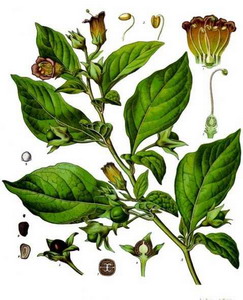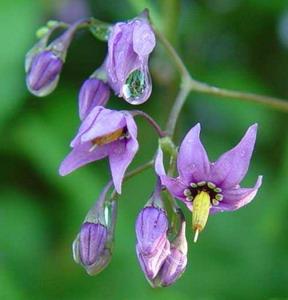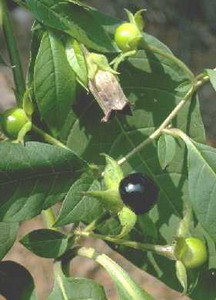|
|
BELLADONNA - DEADLY NIGHTSHADE




 Belladonna, more commonly known as deadly nightshade, Atropa belladonna, devil's cherries, devil's herb, divale, dwale, dwayberry, great morel, naughty man's cherries, and poison black cherry, is a perennial herbaceous plant in the family Solanaceae, native to Europe, North Africa, and Western Asia. The foliage and berries are toxic, containing tropane alkaloids. These toxins include scopolamine, hyoscyamine, and atropine which, while having legitimate medical uses at low doses, induce delirium and hallucinations when ingested in sufficient amounts. Atropine, scopolamine, and hyoscyamine are derived from the plant for use as pharmaceutical anticholinergics. Belladonna, more commonly known as deadly nightshade, Atropa belladonna, devil's cherries, devil's herb, divale, dwale, dwayberry, great morel, naughty man's cherries, and poison black cherry, is a perennial herbaceous plant in the family Solanaceae, native to Europe, North Africa, and Western Asia. The foliage and berries are toxic, containing tropane alkaloids. These toxins include scopolamine, hyoscyamine, and atropine which, while having legitimate medical uses at low doses, induce delirium and hallucinations when ingested in sufficient amounts. Atropine, scopolamine, and hyoscyamine are derived from the plant for use as pharmaceutical anticholinergics.
The tall, branching plant can grow to a height of at least 5 ft (1.5 m), and is native to Europe, North Africa, and Asia and cultivated in North America and the United Kingdom. Belladonna has also been introduced to a number of places, including the United States and Ireland and now grows wild. The root is thick, fleshy and whitish, about 6 inches long, or more, and branching. It is perennial. The purplish coloured stem is annual and herbaceous. It is stout, 2 to 4 feet high, undivided at the base, but dividing a little above the ground into three - more rarely two or four branches, each of which again branches freely.
The leaves are dull, darkish green in colour and of unequal size, 3 to 10 inches long, the lower leaves solitary, the upper ones in pairs alternately from opposite sides of the stem, one leaf of each pair much larger than the other, oval in shape, acute at the apex, entire and attenuated into short petioles.
Though widely distributed over Central and Southern Europe, the plant is not common in England, and has become rarer of late and in Scotland it is very rare. Although chiefly a native of the southern counties, being almost confined to calcareous soils, it has been sparingly found in twenty-eight British counties, mostly in waste places, quarries and near old ruins.. Under the shade of trees, on wooded hills, on chalk or limestone, it will grow most luxuriantly, forming bushy plants several feet high, but specimens growing in places exposed to the sun are apt to be dwarfed, consequently it rarely attains such a large size when cultivated in the open, and is more subject to the attacks of insects than when growing wild under natural conditions.
It has a long history of use as a medicine, cosmetic, and poison. Before the Middle Ages, it was used as an anesthetic for surgery, and it was used as a poison by early men, ancient Romans, including the wives of two Emperors, and by Macbeth of Scotland before he became a Scottish King.
The genus name "atropa" comes from Atropos, one of the three Fates in Greek mythology (the one who cuts the thread of life), and the name "atropa bella donna" is derived from an admonition in Italian and Greek meaning "do not betray a beautiful lady".
The plant in Chaucer's days was known as Dwale, which Dr. J. A. H. Murray considers was probably derived from the Scandinavian dool, meaning delay or sleep. Other authorities have derived the word from the French deuil (grief), a reference to its fatal properties.
The first botanical description was by Linnaeus in Species Plantarum in 1753. It is in the nightshade family (Solanaceae), which it shares with potatoes, tomatoes, eggplants, jimsonweed, tobacco, wolfberry, and chili peppers. The name Atropa is thought to be derived from that of the Greek goddess Atropos, one of the three Greek fates or destinies who would determine the course of a man's life by the weaving of threads that symbolized their birth, the events in their life and finally their death; with Atropos cutting these threads to mark the latter. The name "belladonna" comes from the Italian language, meaning "beautiful lady";originating either from its usage as cosmetic for the face, or, more probably, from its usage to increase the pupil size in ladies.
One of the first widespread uses of the herb was purely a cosmetic one. Sixteenth century Italian women reportedly applied belladonna solutions to their eyes to dilate the pupils and achieve a dreamy and supposedly more desirable appearance (hence the name belladonna, which is Italian for 'beautiful lady'). Atropine, an alkaloid of belladonna that blocks certain nerve impulses, is still used by some opthamologists today to dilate the pupils for eye examinations.
Belladonna has a long history of medicinal applications in healthcare. Belladonna alkaloids are anticholinergic, which means that it works by blocking the certain nerve impulses involved in the parasympathetic nervous system, which regulates certain involuntary bodily functions or reflexes, including pupil dilation, heart rate, secretion of glands and organs, and the constriction of the bronchioles in the lungs and the alimentary canal (digestive tract). Belladonna relaxes the smooth muscles of the internal organs and inhibits or dries up secretions (e.g., perspiration, mucous, breast milk, and saliva).
 Belladonna alkaloids, the active ingredients of the plant, include atropine and scopolamine. These alkaloids are extracted from the leaves and root of the plant and administered either alone or in combination with other herbal remedies or prescription medications. However even tiny doses are toxic and should only be taken by prescription. Belladonna alkaloids, the active ingredients of the plant, include atropine and scopolamine. These alkaloids are extracted from the leaves and root of the plant and administered either alone or in combination with other herbal remedies or prescription medications. However even tiny doses are toxic and should only be taken by prescription.
The various preparations of Belladonna have many uses. Locally applied, it lessens irritability and pain, and is used as a lotion, plaster or liniment in cases of neuralgia, gout, rheumatism and sciatica. As a drug, it specially affects the brain and the bladder. It is used to check excessive secretions and to allay inflammation and to check the sweating of phthisis and other exhausting diseases.
Small doses allay cardiac palpitation, and the plaster is applied to the cardiac region for the same purpose, removing pain and distress.
It is a powerful antispasmodic in intestinal colic and spasmodic asthma. Occasionally the leaves are employed as an ingredient of cigarettes for relieving the latter. It is well borne by children, and is given in large doses in whooping cough and false croup.
For its action on the circulation, it is given in the collapse of pneumonia, typhoid fever and other acute diseases. It increases the rate of the heart by some 20 to 40 beats per minute, without diminishing its force.
It is of value in acute sore throat, and relieves local inflammation and congestion.
Hahnemann proved that tincture of Belladonna given in very small doses will protect from the infection of scarlet fever, and at one time Belladonnna leaves were held to be curative of cancer, when applied externally as a poultice, either fresh or dried and powdered.
Belladonna plasters are often applied, after a fall, to the injured or sprained part. A mixture of Belladonna plaster, Salicylic acid and Lead plaster is recommended as an application for corns and bunions.
Belladonna alkaloids are used to treat a variety of symptoms and conditions, including:
- Gastrointestinal disorders. Because the alkaloids relax the smooth muscles of the gastrointestinal tract and reduces stomach acid secretions, it is useful in treating colitis, diverticulitis, irritable bowel syndrome , colic, diarrhea, and peptic ulcer.
- Asthma. By relaxing the bronchioles, belladonna alleviates the wheezing symptoms of an asthma attack.
- Excessive sweating. Belladonna slows gland and organ secretion, which makes it useful in controlling conditions that cause excessive sweating.
- Nighttime incontinence. Belladonna acts as a diuretic, and can be helpful in treating excessive nighttime urination and incontinence.
- Headaches and migraines. The pain-relieving properties of atropine, a belladonna alkaloid, are useful in treating headaches.
- Muscle pains and spasms. Belladonna is frequently prescribed to ease severe menstrual cramps.
- Motion sickness . Scopolamine, an alkaloid of belladonna, is helpful in treating motion sickness and vertigo.
- Parkinson's disease. Belladonna can alleviate the excessive sweating and salivation associated with the disease, as well as controlling tremors and muscle rigidity.
- Biliary colic. Muscle spasm, or colic, of the gallbladder and liver can be relieved through the muscle relaxing properties of belladonna.
Belladonna is frequently prescribed homeopathic remedy used to treat illnesses that manifest symptoms similar to those that belladonna poisoning triggers (i.e., high fever, nausea, delirium, muscle spasms, flushed skin, dilated pupils). These include the common cold , otitis media (earache), fever, arthritis, menstrual cramps, diverticulitis, muscle pain, sunstroke, toothache and teething, conjunctivitis, headaches, sore throat , and boils and abscesses. As with all homeopathic remedies, the prescription of belladonna depends on the individual's overall symptom picture, mood, and temperament. When used as a homeopathic remedy, belladonna is administered in a highly diluted form to trigger the body's natural healing response without risk of belladonna poisoning or death.
Results of a clinical trial performed at the National Cancer Institute of Milan, Italy, have also indicated that homeopathic remedies of belladonna can be useful in relieving the discomfort, warmth, and swelling of the skin associated with radiotherapy for breast cancer (i.e., radiodermatitis).
Belladonna leaf is harvested between May and July and dried at temperatures no warmer than 140°F (60° C). The roots of Atropa belladonna plants that have reached two to four year old maturity are also harvested for herbal preparations in early fall between mid-October and mid-November. The roots are then cleaned and dried at temperatures no warmer than 122°F (50°C). After drying, the leaves and roots are crushed for use in a number of forms, including decoctions, tinctures, infusions, plasters, pills, suppositories, liquid solutions or suspensions, and powders. They can be used both alone and in combination with other herbs and medications.
 Belladonna is often confused in the public mind with dulcamara (Bittersweet), possibly because it bears the popular name of woody nightshade. The cultivation of Belladonna in England dates at least from the sixteenth century, for Lyte says, in the Niewe Herball, 1578: 'This herbe is found in some places of this Countrie, in woods and hedges and in the gardens of some Herboristes.' Though not, however, much cultivated, it was evidently growing wild in many parts of the country when our great Herbals were written. Gerard mentions it as freely growing at Highgate, also at Wisbech and in Lincolnshire, and it gave a name to a Lancashire valley. Under the name of Solanum lethale, the plant was included in our early Pharmacopoeias, but it was dropped in 1788 and reintroduced in 1809 as Belladonna folia. Gerard was the first English writer to adopt the Italian name, of which he makes two words. The root was not used in medicine here until 1860, when Peter Squire recommended it as the basis of an anodyne liniment. Belladonna is often confused in the public mind with dulcamara (Bittersweet), possibly because it bears the popular name of woody nightshade. The cultivation of Belladonna in England dates at least from the sixteenth century, for Lyte says, in the Niewe Herball, 1578: 'This herbe is found in some places of this Countrie, in woods and hedges and in the gardens of some Herboristes.' Though not, however, much cultivated, it was evidently growing wild in many parts of the country when our great Herbals were written. Gerard mentions it as freely growing at Highgate, also at Wisbech and in Lincolnshire, and it gave a name to a Lancashire valley. Under the name of Solanum lethale, the plant was included in our early Pharmacopoeias, but it was dropped in 1788 and reintroduced in 1809 as Belladonna folia. Gerard was the first English writer to adopt the Italian name, of which he makes two words. The root was not used in medicine here until 1860, when Peter Squire recommended it as the basis of an anodyne liniment.
It is extremely dangerous to self-prescribe belladonna, and it should always be taken under the direction of a doctor or other qualified healthcare professional. The frequency and quantity of dosage will depend on both the patient and the illness the herb is prescribed for, but the doses are always extremely small. For example the Physicians Desk Reference (PDR) for Herbal Medicines recommends an average single dose of 0.05-0.10 g. Each patient's illness is different and some patients experience toxicity at unusually low doses.
Back to the top of the page


|
|
|